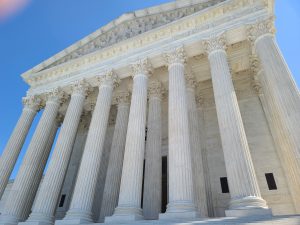When the Supreme Court heard oral arguments in the New York gun-carry case last Wednesday, multiple justices expressed interest in determining the correct framework for evaluating New York’s law and other gun regulations. Lawyers from both sides of the case—and indeed even amicus briefs filed on behalf of both sides—argued for a “text, history, and tradition” approach.
The concept of applying text, history, and tradition as the method of assessing gun regulations is often attributed to Justice Brett Kavanaugh from his time as a judge on the D.C. Circuit Court of Appeals. In his Heller II dissent, then-judge Kavanaugh outlined what a text, history, and tradition test would look like based on the Supreme Court’s landmark decisions in District of Columbia v. Heller and McDonald v. Chicago.
“Heller was up-front about the role of text, history, and tradition in Second Amendment analysis – and about the absence of a role for judicial interest balancing or assessment of costs and benefits of gun regulations,” he wrote. “Gun bans and gun regulations that are longstanding – or, put another way, sufficiently rooted in text, history, and tradition – are consistent with the Second Amendment individual right. Gun bans and gun regulations that are not longstanding or sufficiently rooted in text, history, and tradition are not consistent with the Second Amendment individual right.”
It’s an approach to Second Amendment law that has long been touted by advocates for gun rights who believe such a standard would render many currently existing and future gun laws impermissible. Indeed, there is some evidence for that. Kavanaugh’s Heller II dissent, for example, gave a forceful argument for why Washington, D.C.’s assault-weapon ban and registration requirement would fail under the framework.
However, Kavanaugh also left the door open for many gun-control laws to pass muster under such a test that would not be able to clear other tests.
“Indeed, governments appear to have more flexibility and power to impose gun regulations under a test based on text, history, and tradition than they would under strict scrutiny,” he wrote. “After all, history and tradition show that a variety of gun regulations have co-existed with the Second Amendment right and are consistent with that right, as the Court said in Heller. By contrast, if courts applied strict scrutiny, then presumably very few gun regulations would be upheld.”
Those defending New York’s law understand this and claim the text, history, and tradition approach supports the state’s restrictive permitting regime that allows officials to deny applicants they decide don’t have a “good cause” to carry a concealed gun.
Historian Saul Cornell, a gun-control proponent and one of the amici who filed a brief in support of the law, detailed the good cause permitting regimes that existed in various states throughout the late 19th and early 20th centuries. These regimes granted jurisdictions broad discretion in deciding who could lawfully carry a concealed firearm in public.
“Reconstruction ushered in a period of expansive regulation,” he wrote in a law review article. “Courts, legislators, and commentators during this period recognized that the robust power to regulate firearms, particularly in public, was not only constitutional, but essential to preserve ordered liberty. The key innovation in this period, a development that became the dominant model of firearms regulation in America, good cause permit schemes continue to function as an important part of efforts to address the problem of gun violence.”
As a result, he suggests that such schemes are entirely compatible with a text, history, and tradition framework.
“These laws are indisputably presumptively lawful under Heller’s framework,” he wrote.
Gun-rights supporters have pointed out that many of these laws were passed with ulterior motives, nominally functioning to promote public safety but in reality being used to keep disfavored groups from exercising their right to arms. The same argument was applied directly to New York’s law which opponents argue was passed with the intent to discriminate against Italians and Blacks. However, New York’s defenders argue there’s insufficient historical evidence to explicitly show the racist intent of these laws and say they were applied broadly. They argue concealed carry restrictions, or restrictions on all forms of gun carry, are consistent with the country’s “history and tradition” and thus compatible with the Second Amendment.
This argument was echoed by Brian Fletcher, acting United States solicitor general, in the NYSRPA v. Bruen oral arguments. He dismissed Justice Alito’s inquiry into whether or not racial animus factored into New York’s Sullivan Act—the law that forms the basis for the state’s current carry regime—as insufficiently persuasive while maintaining a preference for the Court to uphold the law under a text, history, and tradition test.
However, Kavanaugh’s Heller II dissent offers some insight into how the Court might view these historical analogs to carry restrictions, even with their racial motivations in dispute. Kavanaugh implied that 20th century or even 19th centuries laws that go against the plain meaning of the Second Amendment’s text don’t hold water despite their age.
“Post-ratification adoption or acceptance of laws that are inconsistent with the original meaning of the constitutional text obviously cannot overcome or alter that text,” he wrote, citing the Court’s reversal on segregation in the landmark case Brown v. Board of Education as an example. “That an unconstitutional action has been taken before surely does not render that same action any less unconstitutional at a later date.”
The petitioners in the case against New York’s restrictive carry law mirrored this line of thinking in crafting their arguments to the Court.
“Founding-era cases, commentaries, and laws on both sides of the Atlantic, most of which were surveyed in Heller, confirm that the founding generation understood the Second Amendment and its English predecessor to guarantee a right to carry common arms for self-defense,” the petitioner’s brief said. “The American tradition of protecting that right remained virtually unbroken in the century and a half following ratification; severe restrictions on the right to carry arms typically arose only in the context of efforts to disarm disfavored groups, like blacks in the South and immigrants in the Northeast. Those outlying and discriminatory efforts only underscore the framers’ wisdom in enshrining the right of all ‘The People’ to keep and bear arms in our founding document.”
Thus, the argument goes, because the Second Amendment was understood to broadly protect a right to bear arms when it was ratified, later laws prohibiting the exercise of that right cannot overcome the actual text of the amendment.
A text, history, and tradition approach—if officially established by the Court in this case—would at the very least clarify how lower courts review future gun cases that will inevitably come before them. While a survey of American history and the original intent of the Second Amendment would seem to lend itself to upholding fewer gun control laws, courts could continue to have discretion in evaluating the historical record, with all of its variety, to justify desired outcomes.
It’s hard to see the Ninth Circuit, for example, completely reversing course from its decision in Young v. Hawaii just because the Supreme Court established such a standard for evaluating gun laws. However, on balance, gun-rights proponents would have cause for optimism if the Court adopts a text, history, and tradition standard moving forward.







Only Members can view comments. Become a member today to join the conversation.